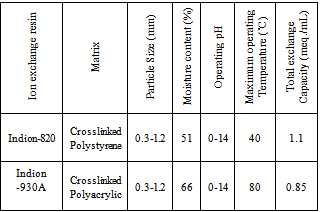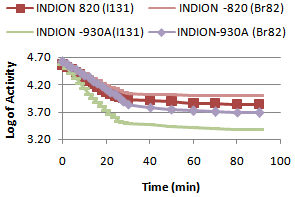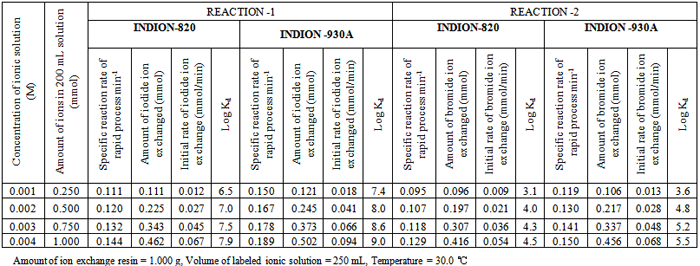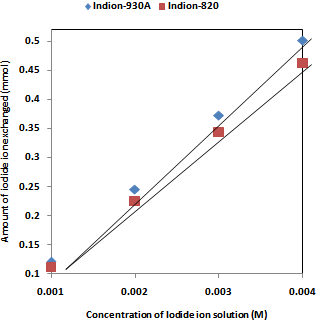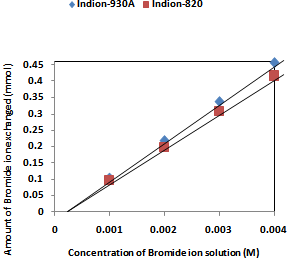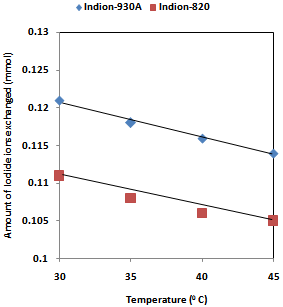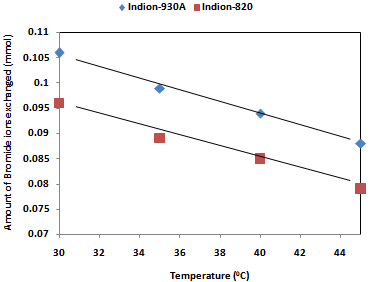-
Paper Information
- Next Paper
- Previous Paper
- Paper Submission
-
Journal Information
- About This Journal
- Editorial Board
- Current Issue
- Archive
- Author Guidelines
- Contact Us
Physical Chemistry
p-ISSN: 2167-7042 e-ISSN: 2167-7069
2012; 2(5): 73-79
doi: 10.5923/j.pc.20120205.03
Comparative Study of Indion-820 and Indion -930A Ion Exchange Resins by Application of 131I and 82 Br as a Tracer Isotopes
Pravin U. Singare
Department of Chemistry, Bhavan’s College, Munshi Nagar, Andheri (West), Mumbai, 400 058, India
Correspondence to: Pravin U. Singare , Department of Chemistry, Bhavan’s College, Munshi Nagar, Andheri (West), Mumbai, 400 058, India.
| Email: |  |
Copyright © 2012 Scientific & Academic Publishing. All Rights Reserved.
The present study demonstrates the application of radioactive tracer technique to assess the performance of industrial grade strongly basic anion exchange resins Indion-820 and Indion -930A. The radiotracer isotopes 131I and 82 Br in aqueous form were used to trace the ion-isotopic exchange reaction kinetics under different operating conditions like temperature and concentration of ionic solution. It is observed that the specific reaction rate (min-1), percentage of ion exchange, and distribution coefficient values calculated for Indion-930A are higher than that calculated for Indion-820. It is expected that the radioactive tracer technique as used in the present investigation can be applied to evaluate the performance of different resins which are synthesized and tailor made for their specific technical applications.
Keywords: Ion Exchange Resins, Indion-820, Indion -930A, Tracer Technique, Ion-Isotopic Exchange Reactions, 131I, 82Br, Reaction Kinetics, Distribution Coefficient
Cite this paper: Pravin U. Singare , "Comparative Study of Indion-820 and Indion -930A Ion Exchange Resins by Application of 131I and 82 Br as a Tracer Isotopes", Physical Chemistry, Vol. 2 No. 5, 2012, pp. 73-79. doi: 10.5923/j.pc.20120205.03.
Article Outline
1. Introduction
- A wide range of ion exchange media is now available, from low cost naturally occurring organic (such as coal and peat) and inorganic (such as clay and natural zeolite) materials to expensive synthetic organics and inorganics engineered to remove specific ions. The chemistry of most ion exchange media has been extensively studied for the nuclear industry and for other applications. The selection of an appropriate medium depends on the needs of the system. However, if there are large concentrations of chemically similar ions in the waste the process of selection becomes more difficult. If low cost general ion exchange media are used, large volumes may be required, leading to larger volumes of waste to treat and dispose of. Higher cost ion specific exchangers may be a better choice, especially when the extra cost of the media is more than offset by the reduction in the total cost for the treatment and subsequent storage and/or disposal of the spent media. The ion exchange media must be compatible with the chemical nature of thewaste (such as the pH and type of ionic species present), as well as the operating parameters, notably temperature and pressure. The limited operating temperature range of most organic ion exchangers requires some liquid streams, such as reactor coolant circuits, to be depressurized and cooled substantially prior to treatment. Efforts to develop new ion exchangers for specific applications are continuing[1-5]. In spite of their advanced stage of development, variousaspects of ion exchange technologies have been continuously studied to improve the efficiency and economy of their application in various technological applications. The selection of an appropriate ion exchange material for treatment of liquid waste is possible on the basis of information provided by the manufacturer. However, since the selection of the appropriate ion-exchange material depends on the needs of the system, it is expected that the data obtained from the actual experimental trials will prove to be more helpful. Hence in the present investigation, it is proposed to test the performance of industrial grade ion exchange resins Indion-820 and Indion-930A under different experimental conditions like temperature and concentration of ionic species present in the external exchanging medium.
2. Experimental
2.1. Conditioning of Ion Exchange Resins
- Ion exchange resin Indion-820 and Indion -930A (by Ion Exchange India Ltd., Mumbai) are strongly basic anion exchange resin in chloride form having quaternary ammonium -N+R3 functional group. Details regarding the properties of the resins used are given in Table 1. These resins were converted separately in to iodide / bromide form by treatment with 10 % KI / KBr solution in a conditioning column which is adjusted at the flow rate as 1 mL / min. The resins were then washed with double distilled water, until the washings were free from iodide/bromide ions as tested by AgNO3 solution. These resins in bromide and iodide form were then dried separately over P2O5 in desiccators at room temperature.
|
2.2. Radioactive Tracer Isotopes
- The radioisotope 131I and 82Br used in the present experimental work was obtained from Board of Radiation and Isotope Technology (BRIT), Mumbai. Details regarding the isotopes used in the present experimental work are given in Table 2.
|
2.3. Study on Kinetics of Iodide Ion-isotopic Exchange Reaction
- In a stoppered bottle 250 mL (V) of 0.001 M iodide ion solution was labeled with diluted 131I radioactive solution using a micro syringe, such that 1.0 mL of labeled solution has a radioactivity of around 15,000 cpm (counts per minute) when measured with γ -ray spectrometer having NaI (Tl) scintillation detector. Since only about 50–100 μL of the radioactive iodide ion solution was required for labeling the solution, its concentration will remain unchanged, which was further confirmed by potentiometer titration against AgNO3 solution. The above labeled solution of known initial activity (Ai) was kept in a thermostat adjusted to 30.0 ℃. The swelled and conditioned dry ion exchange resins in iodide form weighing exactly 1.000 g (m) were transferred quickly into this labeled solution which was vigorously stirred by using mechanical stirrer and the activity in cpm of 1.0 mL of solution was measured. The solution was transferred back to the same bottle containing labeled solution after measuring activity. The iodide ion-isotopic exchange reaction can be represented as:
 | (1) |
2.4. Study on Kinetics of Bromide Ion-isotopic Exchange Reaction
- The experiment was also performed to study the kinetics of bromide ion- isotopic exchange reaction by equilibrating 1.000 g of ion exchange resin in bromide form with labeled bromide ion solution in the same concentration and temperature range as above. The labeling of bromide ion solution was done by using 82Br as a radioactive tracer isotope for which the same procedure as explained above was followed. The bromide ion-isotopic exchange reaction can be represented as:
 | (2) |
|
|
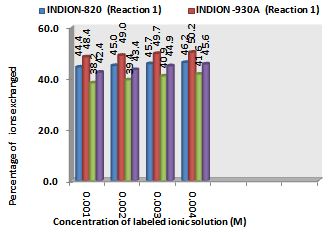 | Figure 2. Variation in Percentage Ions Exchanged with Concentration of Labeled Ionic Solution Amount of ion exchange resin = 1.000 g, Volume of labeled ionic solution = 250 mL, Temperature = 30.0 ℃ |
3. Results and Discussion
3.1. Comparative Study of Ion-isotopic Exchange Reactions
- In the present investigation it was observed that due to the rapid ion-isotopic exchange reaction taking place, the activity of solution decreases rapidly initially, then due to the slow exchange the activity of the solution decreases slowly and finally remains nearly constant. Preliminary studies show that the above exchange reactions are of first order[14, 15]. Therefore logarithm of activity when plotted against time gives a composite curve in which the activity initially decreases sharply and thereafter very slowly giving nearly straight line (Figure 1), evidently rapid and slow ion-isotopic exchange reactions were occurring simultaneously[7-13]. Now the straight line was extrapolated back to zero time. The extrapolated portion represents the contribution of slow process to the total activity which now includes rapid process also. The activity due to slow process was subtracted from the total activity at various time intervals. The difference gives the activity due to rapid process only. From the activity exchanged due to rapid process at various time intervals, the specific reaction rates (k) of rapid ion-isotopic exchange reaction were calculated. The amount of iodide / bromide ions exchanged (mmol) on the resin were obtained from the initial and final activity of solution and the amount of exchangeable ions in 250 mL of solution. From the amount of ions exchanged on the resin (mmol) and the specific reaction rates (min-1), the initial rate of ion exchanged (mmol/min) was calculated. Because of larger solvated size of bromide ions as compared to that of iodide ions, it was observed that the exchange of bromide ions occurs at the slower rate than that of iodide ions[16]. Hence under identical experimental conditions, the values of specific reaction rate (min-1), amount of ion exchanged (mmol) and initial rate of ion exchange (mmol/min) are calculated to be lower for bromide ion-isotopic exchange reaction than that for iodide ion-isotopic exchange reaction as summarized in Tables 3 and 4. For both bromide and iodide ion-isotopic exchange reactions, under identical experimental conditions, the values of specific reaction rate increases with increase in concentration of ionic solution from 0.001M to 0.004M (Table 3). However, with rise in temperature from 30.0℃ to 45.0℃, the specific reaction rate was observed to decrease (Table 4). From the results, it appears that iodide ions exchange at the faster rate as compared to that of bromide ions which was related to the extent of solvation (Tables 3 and 4).From the knowledge of Ai, Af, volume of the exchangeable ionic solution (V) and mass of ion exchange resin (m), the Kd value was calculated by the equation
 | (3) |
3.2. Comparative Study of Anion Exchange Resins
- From the Table 3, it is observed that for iodide ion-isotopic exchange reaction by using Indion-930A resin, the values of specific reaction rate (min-1), amount of iodide ion exchanged (mmol), initial rate of iodide ion exchange (mmol/min) and log Kd were 0.150, 0.121, 0.018 and 7.4 respectively, which was higher than 0.111, 0.111, 0.012 and 6.5 respectively as that obtained by using Indion-820 resins under identical experimental conditions of 30.0℃, 1.000 g of ion exchange resins and 0.001 M labeled iodide ion solution. The identical trend was observed for the two resins during bromide ion-isotopic exchange reaction. From Table 3, it is observed that using Indion-930A resins, at a constant temperature of 30.0℃, as the concentration of labeled iodide ion solution increases 0.001 M to 0.004 M, the. percentage of iodide ions exchanged increases from 48.4 % to 50.2 %. While using Indion-820 resins under identical experimental conditions the percentage of iodide ions exchanged increases from 44.4 % to 46.2 %. Similarly in case of bromide ion-isotopic exchange reaction, the percentage of bromide ions exchanged increases from 42.4 %to 45.6 % using Indion-930A resin, while for Indion-820 resin it increases from 38.2 % to 41.6 %. The effect of ionic concentration on percentage of ions exchanged is graphically represented in Figure 2.From Table 4, it is observed that using Indion-930A resins, for 0.001 M labeled iodide ion solution, as the temperature increases 30.0℃ to 45.0℃, the percentage of iodide ions exchanged decreases from 48.4 % to 45.6 %. While using Indion-820 resins under identical experimental conditions the percentage of iodide ions exchanged decreases from 44.4 %to 41.8 %. Similarly in case of bromide ion-isotopic exchange reaction, the percentage of bromide ions exchanged decreases from 42.4 % to 35.2 % using Indion-930A resin, while for Indion-820 resin it decreases from 38.2 % to 31.4 %. The effect of temperature on percentage of ions exchanged is graphically represented in Figure 3. The overall results indicate that under identical experimental conditions, as compared to Indion-820 resins, Indion-930A resins shows higher percentage of ions exchanged. Thus Indion-930A resins show superior performance than Indion-820 resins.
3.3. Statistical Correlations
- The results of present investigation show a strong positive linear co-relationship between amount of ions exchanged and concentration of ionic solution (Figures 4, 5). In case of iodide ion-isotopic exchange using Indion-930A and Indion-820 resins, the values of correlation coefficient (r) were found to be 1.0000 for both the resins, while for bromide ion-isotopic exchange the values of r were 0.9999 and 0.9998 respectively. There also exist a strong negative co-relationship between amount of ions exchanged and temperature of exchanging medium (Figures 6, 7). For Indion-930A and Indion-820 resins, during iodide ion-isotopic exchange the values of r were found to be -0.9944 and -0.9759 respectively; while for bromide ion-isotopic exchange the values were calculated as -0.9980 and -0.9951 respectively for the two resins.
4. Conclusions
- The experimental work carried out in the present investigation will help to standardize the operational process parameters so as to improve the performance of selected nuclear grade ion exchange resins. The radioactive tracer technique used here can also be applied for characterization of different nuclear as well as non-nuclear grade ion exchange resins.
ACKNOWLEDGEMENTS
- The author is thankful to Professor Dr. R.S. Lokhande for his valuable help and support in carrying out the experimental work in Radiochemistry Laboratory of Department of Chemistry, University of Mumbai, Vidyanagari, Mumbai -58.The authors are extremely thankful to SAP Productions for developing and maintaining the manuscript template.
 Abstract
Abstract Reference
Reference Full-Text PDF
Full-Text PDF Full-Text HTML
Full-Text HTML